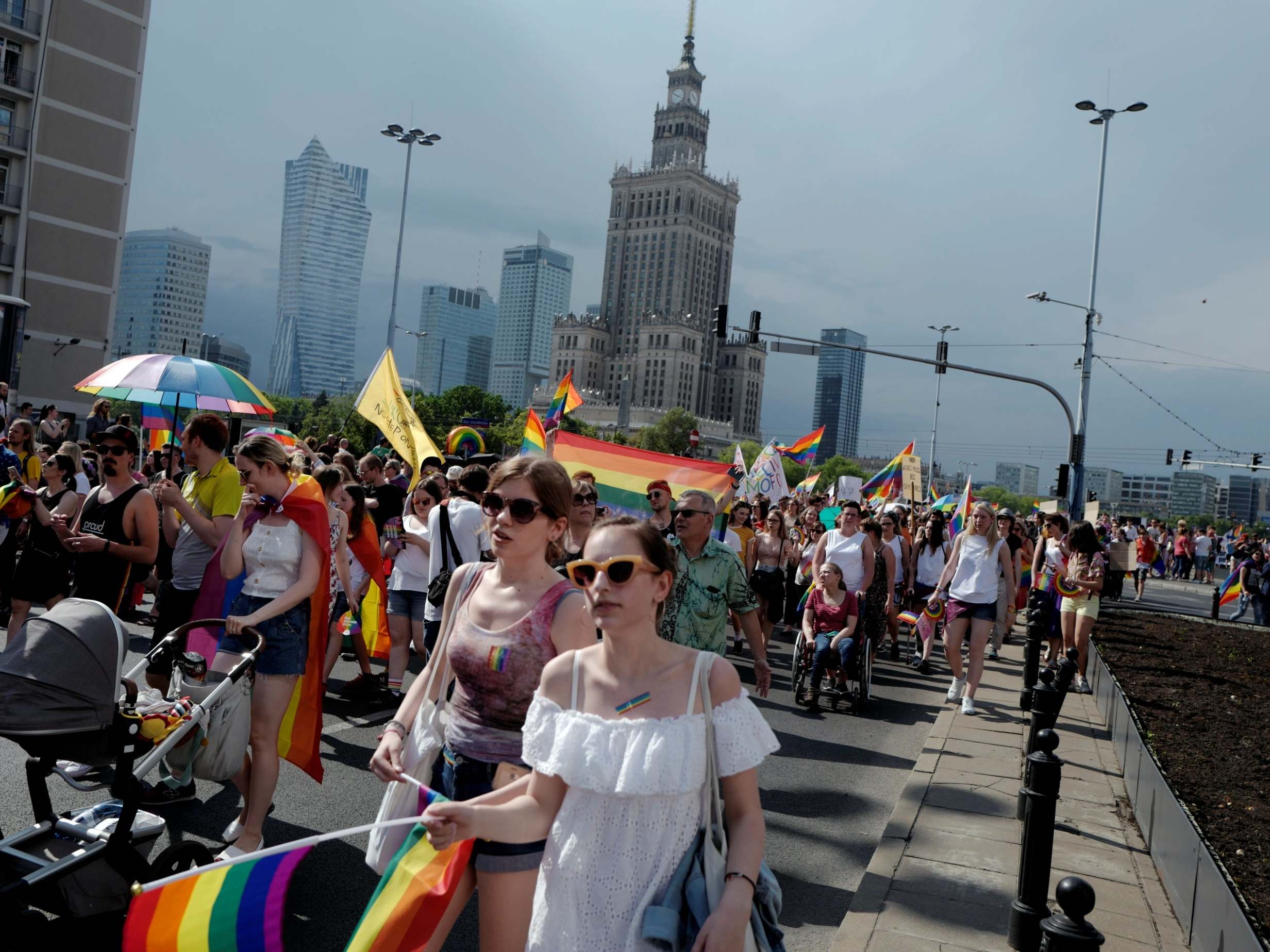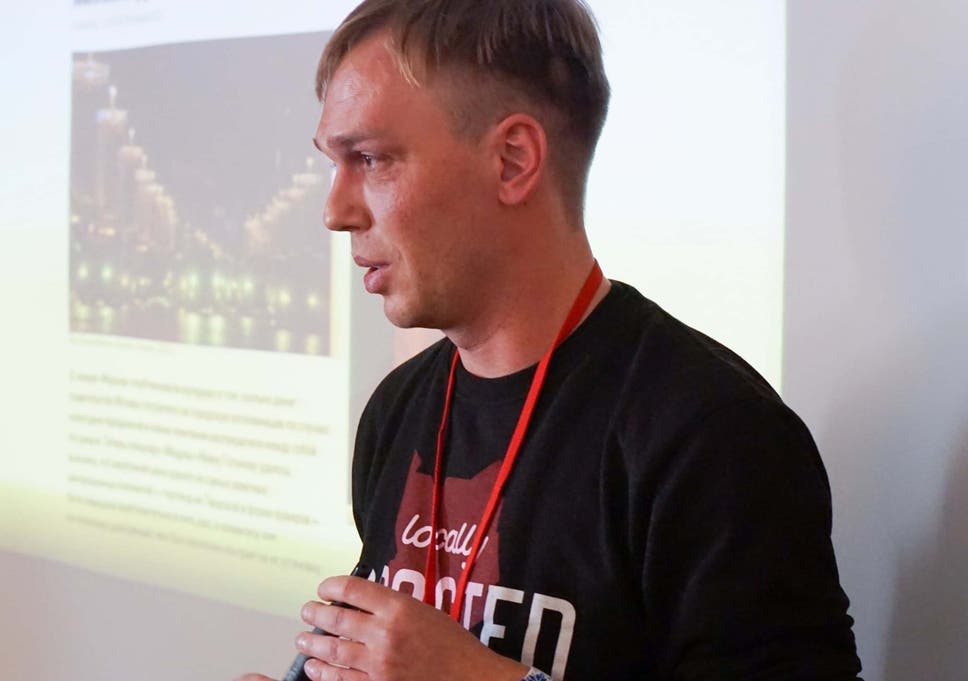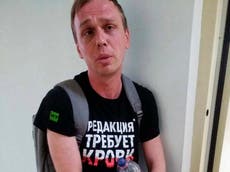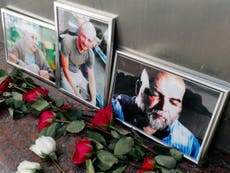GRAIN took a look at the current status of biofortification in Asia, Africa, and Latin America and the emerging critiques from feminist perspectives and food sovereignty movements. What we found is a worrisome push for a top-down and anti-diversity approach to food and health that may ultimately undermine people’s capacities to strengthen their local food systems.
It’s possible that I shall make an ass of myself. But in that case one can always get out of it with a little dialectic. I have, of course, so worded my proposition as to be right either way (K.Marx, Letter to F.Engels on the Indian Mutiny)
Monday, June 10, 2019
THAT DID NOT TAKE LONG LESS THAN 24 HOURS

Joe Biden says he still supports ban on federal funding of abortions, after apparent reversal

Joe Biden says he still supports ban on federal funding of abortions, after apparent reversal
POLAND PRIDE
Meanwhile, in Poland, central and eastern Europe’s biggest pride parade went ahead without major incident, despite rising tensions in the country over the rights of LGBT+ people.
Tens of thousands of people, accompanied by diplomats from the US, Canada and other western countries, took to the streets of Warsaw on Saturday at a time when the Polish government is depicting the LGBT+ community as a threat.

Participants take part at the 'Equality Parade' rally in support of the
LGBT+ community in Warsaw (REUTERS)
In a first, the Polish capital's mayor also participated. Opening the parade, Warsaw mayor Rafal Trzaskowski noted it is now common for cities across Europe to support pride marches.
Meanwhile, in Poland, central and eastern Europe’s biggest pride parade went ahead without major incident, despite rising tensions in the country over the rights of LGBT+ people.
Tens of thousands of people, accompanied by diplomats from the US, Canada and other western countries, took to the streets of Warsaw on Saturday at a time when the Polish government is depicting the LGBT+ community as a threat.

Participants take part at the 'Equality Parade' rally in support of the
LGBT+ community in Warsaw (REUTERS)
In a first, the Polish capital's mayor also participated. Opening the parade, Warsaw mayor Rafal Trzaskowski noted it is now common for cities across Europe to support pride marches.
"Not everyone has to go to the Equality Parade but everyone should respect minority rights," Mr Trzaskowski told the crowd from a parade float. "It's really important for me that Warsaw be open, that Warsaw be tolerant."
City Hall said some 47,000 people took part.
TALKING ABOUT SCIENCE DOES NOT MAKE YOU PRO-ALBERTA OR ANTI-ALBERTA
Some commentators to the piece below are saying that the scientists are "anti-Alberta" while others seem to be bashing Alberta/Albertans for having become wealthier than others through exploitation of fossil fuels. Neither position is helpful. The scientists are not saying that Alberta's fossil fuel industry as such has put the province's forests at greater risk. They are talking about global climate change. But there is no doubt that fossil fuel industries, wherever they are, contribute excessively to greenhouse gas emissions as does cattle raising. In both cases, the current Alberta economy is going to have to give way to such realities though its current government in particular denies any responsibility to act. So, both Canadian and other governments worldwide need to respond in terms of replacing fossil fuels with other energy sources and making it less easy for greenhouse gas emitting industries to survive. As an Albertan, I don't regard that fact as "anti-Alberta" or "anti-Canada" but simply pro-planet

CBC.CA
The Fort McMurray fire and record-breaking wildfire season in B.C. in
Canada’s First World War: A Centennial Series on ActiveHistory.ca
Active History’s series on the history, memory, and legacy of the First World War launched in August, 2014. The series is intentionally broad in outlook, including subjects as diverse as the war’s political impact, life on the home front, and commemoration today. It is edited by Mary Chaktsiris, Sarah Glassford, Nathan Smith, and Jonathan Weier, with former editor Christopher Schultz in a consultative role. If you are interested in contributing to this series, please check out our “Call for Blog Posts” and contact us at: nsmith241@gmail.com
- Reflections on the First World War
- In Conversation IV: Preserving and Passing-On the Legacies of Canada’s First World War
- We need to stop talking about Vimy
- Growing Pains: The Great War Veterans’ Association, Early Poppy Day Campaigns, and the Seeds of Commemorative Tradition
- The Dark Side of Disarmament: Ocean Pollution, Peace, and the World Wars
- Remembrance Day 2018 and Canada’s First World War Centennial
- “The town’s gone wild”: Sounds of Victory in Toronto, 11 November 1918
- First World War Postscript: “Fed Up and Tired” in the Months Following the Armistice
- “Tom’s Return” — or A Girl’s Heroic Adventure? Great War Fiction by a Canadian Schoolgirl
- Embodying Anti-German Sentiment during the Great War: An Archival Moment
- Art as Prescience: Reflections on Sarah Beck’s 2001 ÖDE
- Indigenous Veterans, the Indian Act, and the Origins of National Aboriginal Veterans Day
- “The Equal and Respected Companions of Men”[1]: The Female Veteran of the Great War
- “He Will Again Be Able to Make Himself Self-Sustaining”[1]: Canadian Ex-Officers’ Return to Civilian Life
- The Difficulty in Diagnosis: Shell Shock and the Case of Private Dennis R.
- Coming Home: Veterans, Pensions and the Canadian State After the Great War
- In Conversation III: Touring the Battlefields of Canada’s First World War
- Africa’s War: Anti-colonial Movements and Repression in First World War French West Africa
- Art, Religion, & Iconography in the Vimy Memorial: An Overview
- Six Nations Soldiers and British Women’s Activism during and after the First World War
- The Bolshevik: Art, Revolution and Canada
- Canadian Red Cross Sock-Selling: ‘Fake News’ of the First World War
- In Conversation II: Archiving and Accessing Canada’s First World War
- Red Crosses and White Cotton: Memory and Meaning in First World War Quilts
- The Alderville War Memorial: A Bizarre Monument or A Community’s Search for Meaning?
- Atheists in the Trenches: Loss of Faith among Canadians in the Great War
- National Disunity and the Meaning of Vimy Ridge
- Feet of Clay? Canada’s Vimy Ridge
- Peaceable Kingdom or Emergency State? The Legacy of Canada’s First World War for Security Regulation and Civil Rights
- “You want to put what, where?” Contesting Malpeque’s (Second) First World War Memorial
- Unfit to Fight: The History of Rejecting First World War Volunteers – An Excerpt
- Canada’s History and the First World War Centennial: A Conversation
- A View from the (Editing) Trenches: Summer 2016 and the Challenges of (Knowledge) Mobilization
- “Manna From Heaven” – A YMCA Physical Director at Valcartier and Salisbury Plain
- Vimy Ridge and Canadian Nationalism
- In Conversation: Teaching and Learning Canada’s First World War
- “Deeply regret to inform you”: War and Loss in the Trapp Family
- Performing For War, Hoping For Peace: Canadian Actresses’ Transnational Engagements with World War I
- Golgotha?: D. Y. Cameron’s Flanders from Kemmel
- Marjorie Stinson, the Flying Schoolmarm
- Bleeding Him White: How Canada Stole an Indigenous Veteran’s Identity
- Exploring the Clash of Official and Vernacular Memory: The Great War in Brantford, Brant Country, and Six Nations
- Hidden Messages and Code Words: Bill Alldritt’s Letters as a Prisoner in First World War Germany
- “If ye break faith – we shall not sleep?”
- Further Writing on War, Loss and Remembrance: Reflections on In Flanders Fields: 100 Years
- “Trustees of the Future” and the Echoes of History
- New Archives of Ontario Online Exhibit: Ontario’s WWI Hospital Overseas
- World War One: A Fight for Freedom?
- Soldier-Candidates and the 1917 Wartime Election
- Conscientious Objectors: Fitting Dissent into a Coming of Age Story
- Racist Propaganda and the Shaping of Boys’ Attitudes toward War
- Raising ‘Human Ammunition’: Motherhood, Propaganda, and the Great War
- When writing the First World War comes home: Remembering Pvt. Harold Carter
- Heritage vs. History in the Commemoration of War in Cape Breton Highlands National Park
- A Monument to the Past? The Never Forgotten National War Memorial Project
- A Father’s Grief: The Case of Captain Robert Bartholomew
- The Second Battle of Ypres and the Creation of a YMCA Hero
- “On ‘The Road to 2017’: Reflecting on Canada’s First World War Commemoration Plans”
- The Ideological Work of Commemoration
- Sexing Up Canada’s First World War
- An American Legion in the CEF? Crossing Borders during “Canada’s” First World War
- Passing the Torch: The CBC and Commemoration in 1964 and 2014
- Promises Broken, or Politics as Usual?
- Did You Know the American World War I Museum is in Kansas City?
- New paper – Victory in the Kitchen: Food Control in the Lakehead during the Great War by Beverly Soloway
- 1864 vs. 1914: A Commemorative Showdown
- Podcast – Robert Rutherdale on the Local Responses of WWI
- World War One in Winnipeg – Conscription
- Anti-War Poetry in Canadian Newspapers at the Beginning of the First World War
- Comic Art and the First World War
- A Canadian Observing the Great War Centenary in London, UK
- ‘1914-1918 In Memoriam’: A View from the Grandstand
Thinking about Genocide and Mass Murder: How Could it Have Happened in Nice Canada?
By Alvin Finkel
The decision of the Commission on Missing and Murdered Indigenous Women to use the word “genocide” to describe past Canadian state policies regarding Indigenous women has occasioned heated debate about whether that word is appropriate for anything short of a conscious state plan to rapidly physically eliminate all members of a defined group or to thoroughly destroy their culture and thus eliminate them as a unique entity. The Commission suggests that in fact the latter has been the goal of Canadian governments all along and that condoning physical violence against Indigenous women has been an unstated side effect of attitudes and policies that deny the right of Canada’s Indigenous people to preserve their millennial cultures.
Decisions about what human horror stories qualify as genocide are largely political. There is, of course, consensus that Hitler planned to murder all Jews and managed to kill the majority of them in areas that were under German control at some point during his rule. His murder of Roma was also clearly genocide.
But what about the Holodomor, the murder through famine in Ukraine in 1932-1933? There may have been as many deaths of Ukrainians as a result of Stalin’s maniacal efforts to collectivize and industrialize Ukrainian farming so as to accelerate Soviet industrialization as of Jews in the Holocaust. Many historians and governments view the famine as a genocide, but the Russian government and some historians deny that Stalin, while unbending in his efforts to collectivize peasants’ landholdings, meant to eradicate the Ukrainians as an ethnic group. But claims that he was only involved in misguided class warfare against peasants are contradicted by the Soviet decision to distribute crops seized from Ukrainian peasants not to Ukrainian workers but to workers in other republics, leaving that republic’s workers to share the fate of their peasant co-ethnics.
While most Western scholars seem inclined to qualify the Soviet-induced Ukrainian famine as a genocide, one almost never sees that term employed in discussions about British-induced famines in India and elsewhere. Colonial-era famines began with one in Bengal between 1770 and 1773 that wiped out 10 million lives, a third of all Bengalis. Within a decade another two famines, one in South India’s Tamil region and one in North India, accounted for another 20 million deaths. In all three cases, and many more before independence, the famines were the product of forced monoculture for export purposes and refusal of the British authorities to allow imports of food from areas unaffected by crop failures to the suddenly infertile regions.
Apologists for the British authorities suggest that such famines predated the British and were nature’s way of reducing overpopulation in India. But Indian scholars reject such claims, noting that traditional Indian economies featured a variety of crops as well as gathered fruits and vegetables, irrigation projects, storage of surpluses, and sharing arrangements across wide areas so as to provide insurance for all in case of scarcities. Even during the British raj, the princely states that paid tribute to Britain, but were not incorporated into the area under direct British rule, fared far better than the areas firmly under Britain’s thumb.
The last of the Bengal famines occurred after the Holodomor. In 1942-3, though Bengal produced a bumper crop of rice, two to three million Bengalis died of famine as the British authorities exported most of that crop to reinforce the war effort. Again, it was a decision not to feed people rather than a lack of food that resulted in Indian deaths. In short, what India experienced for much of the colonial period was a kind of economic genocide that paralleled the Holodomor but under capitalist conditions.
Similarly, though we tend to think of the “Irish famine” of 1846, which resulted in at least a million deaths and two million Irish fleeing their country, in terms of the failure of the potato crop, Ireland produced enough food that year to easily satisfy the food requirements of all of the Irish people. But British policy insisted upon the export of most of the crops out of Ireland, leaving Ireland’s poverty-stricken masses, to whom London offered minimal relief, in hunger.
Certain Irish stereotypes create the notion that the potato growers created their own fate because they focused on one crop and an unreliable one at that. In fact they had little choice since the English had much earlier dispossessed them of the better lands on their island, leaving them to attempt to survive in the marginal areas where the potato was about the most reliable crop they could grow. Like the Indian farmers, the Irish were victims of Britain who were stereotyped as the authors of their own misfortune.
Across Africa and Asia, the various European countries imposed regimes of quasi-slavery that left millions dead. The armies of Belgian’s King Leopold II, forcing the Native people of the Congo to supply limitless ivory and rubber, slaughtered between six and ten million of the 20 to 30 million people estimated to be living in the Congo basin.
“Economic genocide” also best describes the fate of the Indigenous peoples of the Americas who were conquered by Spain and Portugal. While the numbers of people in the Americas in 1500, as European colonization began, are calculated as from anywhere from 20 million to 100 million, there were only 1.5 million Indigenous people across the two continents by 1650. While European germs killed many, populations did spring back if they were largely left in control of their lands and their labour as was the case in the fur trade. But for the most part that did not happen. In Potosi, in Bolivia, as many as 4 million miners died in the silver mines over several centuries. The Spanish mineowners forced Indigenous men into the mines to work until their death without ever seeing daylight again and then replaced the dying with slaves still alive.
Because of the fur trade, the early Canadian story of European-Indigenous relations seems tame compared to the Spanish American story. But as settlement replaced the fur trade, dispossession of Indigenous lands, and then efforts to destroy their cultures and break their spirits came to British North America and then Canada. The dispossession was arguably less violent than in the United States not because the Canadian authorities were gentler than because the American experience showed Canadian Indigenous people that it was impossible to fight people who had so little regard for human life as Europeans. In any case, what followed was a horror story that still has not ended despite many Canadian politicians expressing fine words completely disconnected from their actions.
Like the British—and like the Americans, whose record in slaughtering Indigenous people, Latinos, and Asians also counts in the millions—Canadians like to think of themselves as civilized folks whom no respectable person can accuse of genocide or even racism except for the most common-garden variety. Stephen Harper as prime minister famously said that Canada had no history of colonialism. But those who study Indigenous-colonial relations know better, and whether or not we want to use the term “genocide” to describe a long history of racism and sexism towards Indigenous peoples, we need to come to terms with our nation’s savagery towards the first inhabitants of our continent. And we need to act on what commissions like the Truth and Reconciliation Commission, and now the Commission on the Murdered and Missing Indigenous Women have recommended. Or we will never get beyond wordplay as opposed to implementing social justice.
Alvin Finkel is the author of Compassion: A Global History of Social Policy. He is professor emeritus of History at Athabasca University, president of the Alberta Labour History Institute, and co-author of the two-volume History of the Canadian Peoples, now in its 7th editions.
Ivan Golunov: Friends celebrate partial victory after Russian courts release journalist on house arrest
Oliver CarrollSt Petersburg @olliecarroll

vmestemedia.ru/Reuters
Friends and colleagues of a Russian investigative journalist arrested on drugs charges are celebrating after a court unexpectedly defied prosecutors’ recommendations to incarcerate him.
The decision to instead release Ivan Golunov under house arrest is highly unusual for a system that rarely operates in reverse gear. Almost certainly, the move is in response to spirited protests that have broken out following news of the journalist’s detention on Friday. But Saturday’s ruling is also far from the final word on the matter, with police officials and state TV launching a spirited defence of the prosecution.
That a behind-the-scenes battle was developing in government was clear from the unexplained delays that accompanied the start of proceedings in Moscow’s Nikulinsky Court. Mr Golunov appeared in court, inside the bare metal cage designed for defendants only after 8 pm, a full 11 hours later than scheduled.
In emotional scenes, the journalist waved at his colleagues, who shouted messages of support. At one point, he broke down in tears.
“I never thought I would attend my own funeral," he said.
Earlier on Saturday, state investigators formally charged him on drugs offences, alleging that 5.37 grams of cocaine were found in Mr Golunov’s Moscow apartment. The amount was just enough to be considered under a serious drugs charge and a tariff of 10-20 years imprisonment. They had pushed for him to be kept incarcerated while awaiting trial.
Friends and colleagues have described the charges as an outrageous set-up.
In a joint statement, Mr Golunov’s editor and publisher at Meduza, a liberal online publication, said they had no doubt that their journalist was innocent.
“We know Ivan received threats in the last months,” they wrote. “We know in connection to which text, and we can guess from who. We will find out who is behind this and we will make the information public.”
Friends told The Independent that they had never seen Mr Golunov taking drugs.
“His only drug is curiosity,” wrote former colleague Leonid Bershidsky on Twitter. “In Russia that’s against the law.”
Read more

Russian investigative journalist detained for ‘drug dealing’
One of Russia’s most conscientious investigative journalists, Mr Golunov has a reputation for probing some of the country’s most dangerous fields.
His recent stories have uncovered corruption and malpractice in local government and in the loan shark business. But The Independent understands that he was most likely targeted in relation to his muckraking around Russian funeral services — a particularly corrupt sphere controlled by mafia groups and high-ranking state officials.
On Sunday, it was revealed that the journalist was working on an investigation linking the head of the Moscow division of Russia’s security agency to corrupt funeral service schemes. Meduza has promised to release the investigation shortly.
Mr Golunov's arrest has been accompanied by an an unexpectedly strong show of solidarity from Russia's journalistic community and beyond.
Even usually cautious voices like Vladimir Pozner, a veteran of Soviet and Russian television, criticised his arrest in strong terms.
“The arrest of Ivan Golunov to spit in the face of every Russian journalist,” he said. “I don’t like it when people spit in my face.”
Several stars of state TV added their names to a petition demanding Mr Golunov’s release. But by Sunday morning, state news broadcasters had reverted to a more traditional position, airing a new “documentary” in support of the police investigation. Mr Golunov had, they alleged, been caught pushing drugs in Moscow clubs. He was also drunk when arrested — a statement that was completely incompatible with images of medical reports they broadcast that actually showed the opposite. Later, the channel was forced to apologise.
Mr Golunov lawyers insist that police broke the law at every stage of his detention. For several hours, they say, police denied the journalist his rights to see a lawyer. They refused to test journalist's fingers to indicate if had even touched the drugs assigned to him. They refused to take fingerprints of the bags themselves. And they searched his apartment without witnesses present.
Soon after Mr Golunov’s arrest, police officials published four photographs purporting to show a drugs laboratory in what they said was the journalist’s apartment. Later, a spokesman rolled back those comments, and said only one of the photos was, in fact, taken there. At the same time, the spokesman insisted Mr Golunov had some unstated connection to the drugs laboratory depicted in the other pictures.
There are strong suspicions that Mr Golunov has been beaten while in police custody with the aim of obtaining a confession.
Read more

Russian journalists' murder 'pre-planned', say private investigators
On Saturday afternoon, following two ambulance visits, Mr Golunov was transferred to Hospital no. 71 in the West of the city. An official statement confirmed he had been preliminarily diagnosed with a concussion and fractured ribs.
That statement was later disputed by the hospital’s head doctor, Alexander Myaslakov, who said there was no way of knowing how Mr Golunov had received his injuries.
Only afterwards was it revealed that Doctor Myaslakov might not have been well placed for an objective assessment of his patient. A regular contributor to propaganda talk shows on state TV, Dr Myaslakov was also, it transpired, an official representative for President Vladimir Putin during his last campaign. Eventually, Dr Myaslakov admitted to having “no sympathy” for the journalist. “As is well known, I’m a conservative man (and a Soviet one as well),” he wrote on Instagram.
That statement added to the sense of scandal around Mr Golunov’s detention, with hundreds risking arrest to protest outside police stations and courtrooms.
According to Proyekt, an investigative publication with good sources in government, the unexpectedly strong civil response has created unease among Russia’s leaders. On the one hand, police authorities are pushing the Kremlin hard for a custodial sentence. On another, it is unclear the Kremlin is ready for such a radical turn.
Anton Kobyakov, an advisor to Vladimir Putin, told state news agency TASS that the Kremlin had decided to take the case under special control.
Mr Kobyakov was unusually critical of the police decision to present photographic evidence as if it was taken in Mr Goldunov’s apartment.
“Deception and manipulation of facts are covered by articles in the criminal code,” he said. “Those responsible will be made to answer.”
Three of Russia's leading newspapers took the unusual step on Monday of publishing identical front page headlines to protest over what they suspect is the framing of an investigative journalist on drug charges.

Russian media, celebrities protest against investigative journalist's drug bust
Subscribe to:
Posts (Atom)





